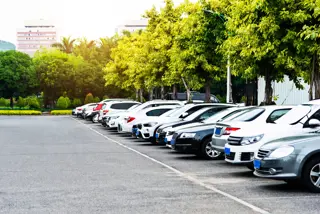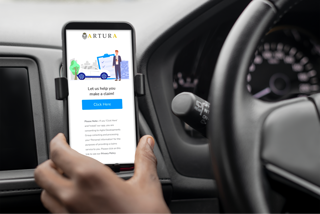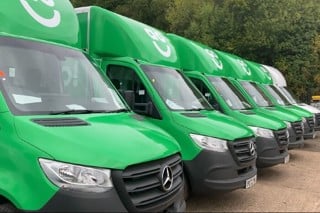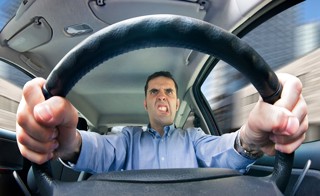There’s a rapidly-growing library of film clips that look like spoof viral videos, until you realise that they are real-life recordings of incidents of life, licence loss and death.
Forward-facing cameras in fleet vehicles have captured the footage, which reveals moments of madness by other road users as well as examples of organised crime.
Welcome to the hidden world of in-cab cameras, hi-tech eyewitnesses to what actually happens when vehicles collide.
This recorded testimony is increasingly resolving insurance claims and prompting ever more fleets across the country to install cameras in their vehicles.
Initially this investment was intended to provide protection from insurance fraud via so-called ‘crash for cash’ scams.
These would see criminal gangs deliberately contrive crashes in order to claim for fictitious personal injuries, vehicle repairs and replacement hire car.
The illegal practice is alarmingly simple to execute and fleets, especially liveried commercial vehicles, have found themselves under attack.
“Gangs have specifically targeted branded vehicles because they know the vehicle will be insured, it is unlikely to be driven by the owner, and the driver is less likely to defend a claim as vigorously as an owner,” says Matt Warden, managing director of corporate motor insurance at Towergate Insurance.
The Insurance Fraud Bureau estimates that ‘crash for cash’ fraud costs the insurance industry £392m each year.
To avoid becoming part of these statistics, National Windscreens (South East) has installed an advanced vehicle camera solution from Intelligent Telematics across its glass fitting fleet.
“We are seeing an increase in crash for cash, bogus whiplash and fraudulent claims, so the vehicle cameras will help us protect our engineers and avoid unnecessary insurance costs,” says Dave Quarterman, managing director of National Windscreens (South East).
“Since installing the solution we have already successfully challenged two claims by proving what actually took place, demonstrating its importance to our business.”
Like many fleet decision-makers (a fleetnews.co.uk poll found that 69% of respondents would consider using in-cab cameras, while 15% already do), Quarterman is now looking to use the high-definition footage to start a virtuous circle.
The video will illustrate other data gathered both of collisions and near misses, allowing the company to respond immediately to any accidents or incidents involving its vans and consequently minimise financial and operational risk.
The end goal is significant cost savings from improved driver behaviour, lower accident frequency, shrinking insurance claim costs and the reduced premiums that follow.
Many insurers seem persuaded of the benefits of in-cab cameras and the footage they provide, and are increasingly prepared either to contribute towards the cost of the camera equipment or offer premium reductions to make the installation of cameras more affordable and attractive to cost-conscious fleets.
Moreover, as the price of the technology has tumbled, so the economic case for installing cameras, not just in HGVs but also in vans and cars, has strengthened.
“Installing cameras is not a good idea… it’s a great idea,” says Larry Smith, regional trading director of Towergate Insurance. “It’s the ability to settle claims really quickly; the evidence is indisputable.”
This is transforming the resolution of contested claims that previously would have left insurers with no option but to accept 50:50 liability.
And with conclusive film evidence, the faster a claim can be settled, which further drives down costs.
For fleets with a rapid turnover of staff, such as courier firms, the camera evidence can help to settle claims after an employee or agency driver has left the business.
And daily rental firms are seizing the opportunity to protect their expensive assets by installing cameras to record a hirer’s driving experience.
Insurance company Swiftcover is already offering a 10% reduction in premiums to drivers who fit a dashcam.
“We believe that by using a dashcam and being able to accurately and quickly establish who was at fault, we will save money and therefore motorists will significantly benefit from lower premiums and more responsible driving,” says Roman Bryl, Swiftcover product manager.
On the fleet side, evidence is mounting that the installation of cameras leads to an immediate improvement in behaviour behind the wheel as drivers realise that any poor decisions or actions will be captured for posterity.
“We see a reduction in accident frequency even before the cameras go in, as drivers start to modify their behaviour,” says Mark Berry, international sales director of SmartWitness Vehicle CCTV. “Then when the cameras go in it goes down exponentially.”
In a further win, it’s not just accident frequency that declines but also the cost of claims, as Sam Footer, head of international business and strategic development at Intelligent Telematics, explains.
“We have done a six-month trial with one big fleet where half the vehicles had cameras fitted. They had a 55% drop in accident numbers and a 25% reduction in claims costs compared to the other half of the fleet that did not have the cameras.”
One reason for the lower claims costs is the speed with which fleet managers or their accident management companies can start to deal with incidents.
New 3G cameras can send an accident alert back to base within a second of the collision occurring, and the video footage follows within a couple of minutes.
By intervening swiftly in at-fault accidents, fleets can limit their exposure to high costs for vehicle recovery, replacement vehicles and repairs.
“The fleet manager can make sure the driver is ok, and deal with the accident immediately,” says Footer.
“The system provides images and GPS data and that information is gold dust because it allows fleets to intervene and deal with a claim immediately, and that drives down the cost of claims.”
This opportunity to have complete, instant visibility of all collisions and driving incidents has led Krispy Kreme, the global doughnut company and coffeehouse chain, to install Intelligent Telematics’ IT1000 forward-facing camera system across its UK fleet of delivery vans.
“By selecting a 3G vehicle camera, we can gain a live view of any incidents to ensure we are operating a safe and responsible fleet, while at the same time target insurance and fuel savings,” says Ben Povey, logistics manager at Krispy Kreme.
He adds that the video footage and incident data gathered by the sophisticated system will support Krispy Kreme’s driver training programme, highlighting another area where in-vehicle cameras can pay dividends. These new systems can trigger alerts of harsh driving back to the fleet controller, even when no accident has occurred.
A G-force sensor within the equipment identifies instances of excessive acceleration and braking, as well as violent swerves to the left or right, and can record the relevant video for subsequent analysis.
This can help employers to identify higher risk drivers and introduce appropriate defensive driver training.
“Technology is only as good as the people using it,” says Simon Marsh, managing director of FleetsCompare, a new company established to help fleets work with insurance brokers that understand the benefits of using vehicle cameras and telematics. They use information from these sources in order to lower the frequency and cost of claims, reduce premiums and promote road safety.
A former fleet manager running 200 commercial vehicles, Marsh started trialling in-vehicle cameras in 2006, using the information generated to review both accidents and near misses as part of the company’s driver training programme.
“When you watch footage back you can see what has happened, and the opportunity to intervene to show drivers where they are driving poorly is invaluable,” he says.
“It’s about making them realise the implications of their actions. A split second could make the difference between going home in the evening or not going home at all.”
Watch the footage
Dramatic footage captured on in-cab cameras often helps resolve insurance claims swiftly resulting in significant savings.
The videos are also popular with internet users, usually attracting thousands of viewings on websites such as YouTube.
Many of these videos can be watched through the Fleet News website. Here we highlight three incidents featured on fleetnews.co.uk:
- Footage of this head-on collison caused by a driver rushing to work, captured on a SmartWitness camera, helped to correctly attribute blame and settle the insurance claim quickly - fleetnews.co.uk/head-on
- A Volkswagen Tiguan was shunted 90° to the side after it was hit by a car jumping a red light. The SmartWitness camera footage resulted in a £5,000 insurance claim quickly being settled - fleetnews.co.uk/red-light
- An in-cab camera from the Vehicle Group has clearly shown the fraud of a ‘crash for cash’ scam in this video - fleetnews.co.uk/crashcam
These videos and more collisions and near-misses can be found at fleetnews.co.uk/video
Dash-cam FAQs
Is the camera evidence submissible in court?
“Yes, anything that drivers have filmed will be admissible in court,” says David Barton, specialist motoring lawyer.
“Courts are having to decide about the accuracy of events that may have taken place six months ago and which took only a few seconds. The court has to decide what weight to attach to people’s memories. If the footage shows you did not do what you are accused of doing that would be enormously helpful in defending a claim. If the footage shows you are at fault you are under no obligation to show it and implicate yourself.”
How will drivers react to the cameras?
“Sometimes there’s an initial anti-Big Brother reaction, but drivers soon come around, especially when there has been an accident and we can prove instantly it’s not the driver’s fault,” says Sam Footer, head of international business and strategic development at Intelligent Telematics. “We pitch them as independent witnesses, not a spy in the cab,” says Matt Warden, managing director, corporate motor insurance, Towergate Insurance. “They are there to support the driver’s version of events and protect them from poor drivers. We only need the film clip when you need the clip.”
How do the cameras work?
The cameras constantly film what is happening on the road ahead. When the G-force sensor in the camera is triggered by a violent manoeuvre, such as harsh braking, harsh acceleration or a swerve, the camera stores the data from the previous minute leading up to the incident and its aftermath. This is either recorded on an SD card in the camera or on a hard drive in the vehicle that then automatically emails the footage using 3G mobile phone coverage.
Can drivers delete evidence of their own poor driving behaviour?
“The camera is tamper-resistant, hard-wired and secure,” says Mark Berry, international sales director of SmartWitness Vehicle CCTV.
What should I look for in a camera?
“The most important thing to bear in mind when buying a dashboard camera is image quality across a range of conditions,” says consumer body Which?. “If image quality isn’t high enough, you might not be able to use your footage in the case of an accident to prove you’re not to blame. Image quality varies enormously between the best and worst dashboard cameras. And while a good dashboard camera may show number plates and faces clearly – allowing you to prove exactly what happened in the event of a collision – a bad dashboard camera could just show a fuzzy mess.”
SD card or 3G?
Recording video on SD cards is generally cheaper, but when a collision does occur the card needs to be removed from the vehicle and the data uploaded to a computer, which can introduce delays into the system, hampering the control of at-fault claims.
“With a 3G camera a signal is sent within one second of the G-Force sensor being triggered, and the fleet manager can view it within two minutes. Also, SD cameras can fail and the fleet manager does not know the camera has gone down. With our 3G camera a ‘heartbeat’ pings into the camera every six hours to check it’s still working,” says Sam Footer.
“But 3G cameras are reliant on a mobile phone signal, which is getting there but not 100% reliable,” adds Matt Warden.
Crash for cash – how it’s done
Deliberately staging or causing road traffic collisions is costing the British insurance industry £392 million a year, inflating premiums and leaving self-insured fleets wide open to high cost claims.
The scam typically involves a motorist on a main road flashing their lights to invite a driver waiting on a side road to pull out only to broadside the unwitting victim. The scammer subsequently claims that the victim pulled out without checking first.
Alternatively, the scammer brakes suddenly, frequently having disabled his vehicle’s brake lights, making it very difficult for the vehicle behind to avoid colliding. In most rear end shunts, it’s the driver of the vehicle behind who is considered to be at fault.
“Innocent motorists are being targeted on roads by fraudsters motivated by greed. By deliberately causing accidents, fraudsters are gambling with the lives of innocent people,” says David Neave, chairman of the Insurance Fraud Bureau.
In one case, office workers in Cheadle became suspicious at the frequency of accidents on the roundabout below their office.
While the vehicles involved were all different, the driver was the same. He was implicated in 90 accidents over a three-year period leading to insurance claims of more than £2 million, and was jailed for four-and-a-half years for his role as a stooge driver.
Fifty people were convicted as part of the investigation, and three of the ringleaders received prison sentences totalling 13 years.





















colin - 04/06/2015 14:07
Do any vehicle manufacturers fit dashcams as standard does anyone know?